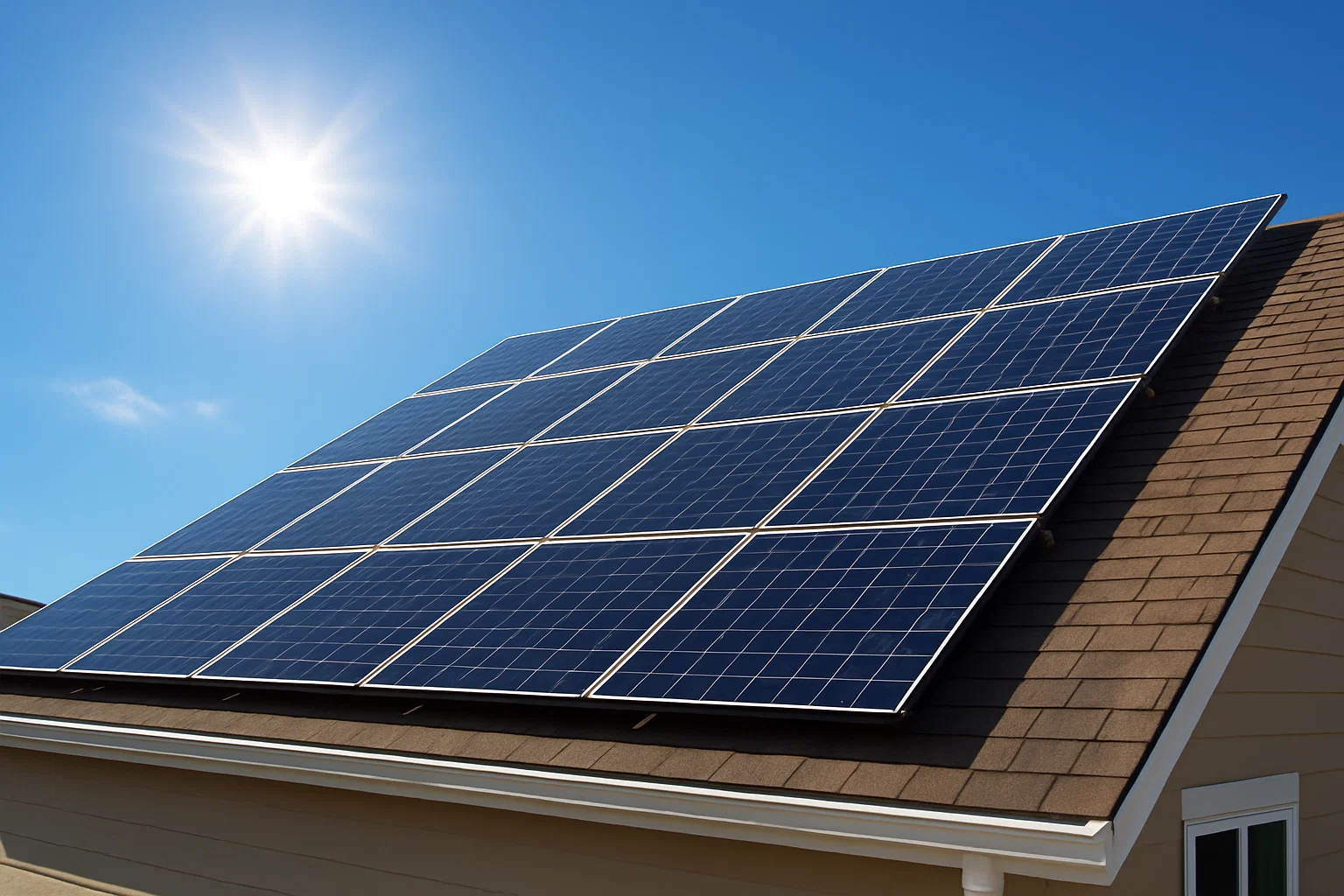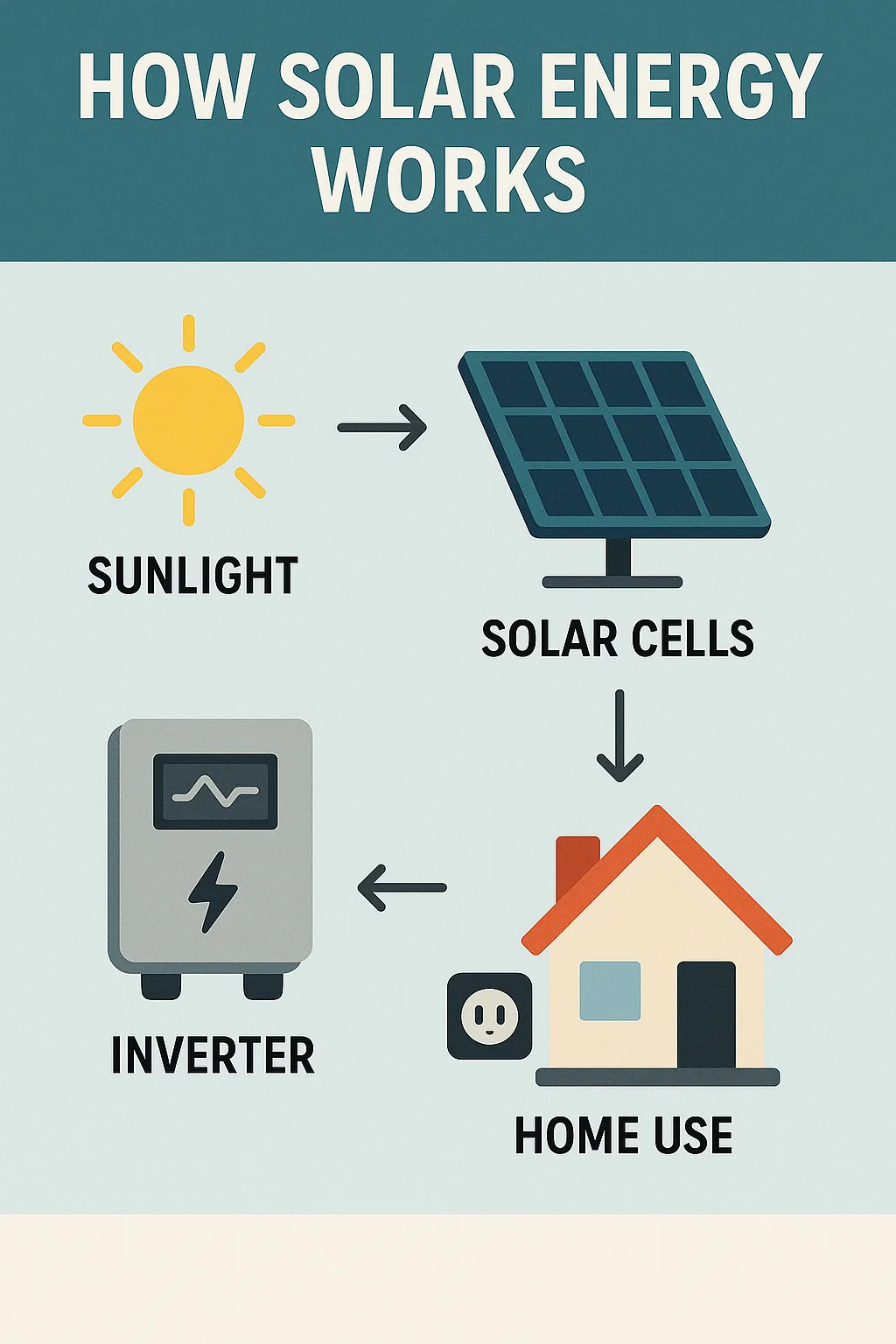
Why Solar Energy Matters in 2025
In 2025, solar energy isn’t just a buzzword it’s a lifeline for our planet. As global temperatures climb and fossil fuels deplete, sunlight has become one of the cleanest, most abundant sources of power we can rely on. According to the International Energy Agency (IEA), solar accounted for nearly 18% of global electricity generation in 2024 a number growing each year.
Countries like India, China, and the United States are leading the charge with massive solar farms and rooftop installations. In California, for example, over 1.5 million homes now generate their own electricity through solar panels. For small business owners and families, the attraction is clear: lower bills, cleaner air, and a more stable future.
But how does sunlight actually power your phone, laptop, or home appliances? Let’s break it down in plain English.
Understanding the Basics: How Solar Panels Turn Sunlight into Power
Think of a solar panel as a light-to-electricity translator. When sunlight hits a solar cell typically made of silicon it triggers the photovoltaic (PV) effect. This process releases electrons, creating an electric current.
Each solar panel contains dozens of these PV cells wired together. The electricity they generate is direct current (DC) but your home runs on alternating current (AC). That’s where the inverter comes in, converting DC to AC so you can use it for lights, TVs, and chargers.
To visualize it:
- Sunlight in → electrons move → DC power out → inverter converts → AC power flows through your home.
This entire conversion happens silently and instantly, every time sunlight touches your panels.
Components of a Typical Solar Power System
A solar setup isn’t just panels on a roof. It’s a coordinated system designed for efficiency and safety.
Solar Panels (Photovoltaic Cells)
These capture sunlight and create DC electricity. They’re built from silicon wafers the same material used in computer chips known for their ability to conduct energy efficiently.
Inverter (DC to AC Conversion)
The inverter is the brain of the system. It transforms DC into AC electricity, synchronizes with your grid, and even helps detect issues.
Battery Storage
Not all systems include this, but batteries store excess power generated during the day so it can be used at night or during outages. Popular options include Tesla Powerwall and LG Chem RESU.
Net Meter and Grid Connection
A net meter tracks how much electricity you use versus how much your system sends back to the grid. When you generate more than you consume, you earn credits a process called net metering.
Together, these components allow you to harness sunlight, store power, and interact intelligently with your utility grid.
Does Solar Work When It’s Cloudy or Raining?
This is one of the biggest myths in solar energy.
Yes, solar panels still work on cloudy or rainy days, just at reduced capacity. Clouds diffuse sunlight, but photons (light particles) still reach the panels. Modern solar panels can operate at 10–25% efficiency even in overcast conditions.
For example, Germany, a country known for its cloudy weather, remains one of the top solar power producers in the world. The key is consistent exposure and efficient panel design not necessarily blazing sunshine.
Rain can even help your panels by washing off dust and dirt, keeping efficiency high without manual cleaning.
Can a House Run 100% on Solar Energy?
Absolutely but it depends on how well the system is designed.
To go completely solar, your system must:
- Generate enough electricity to match your daily usage.
- Include sufficient battery storage for nighttime or cloudy days.
- Be optimized for your region’s sunlight hours and roof angle.
A small, energy-efficient home in Arizona or Rajasthan can easily run 100% on solar. Larger homes in cloudy areas might need hybrid systems solar plus grid backup.
Take the Solar Settlement in Freiburg, Germany, for instance. This community produces more energy than it consumes, selling the surplus back to the grid. It’s a real-world proof that full solar independence is achievable with proper planning.
The Economics of Solar: Does It Really Pay for Itself?
This is where solar gets interesting.
While the initial installation cost (usually $10,000–$20,000 for a standard home system) might seem high, the long-term savings often outweigh the expense.
Here’s a simplified breakdown:
| Factor | Typical Range | Explanation |
|---|---|---|
| Initial Cost | $10,000–$20,000 | Includes panels, inverter, and installation |
| Monthly Bill Savings | $80–$200 | Depends on energy rates and system size |
| Payback Period | 6–10 years | After which your power is nearly free |
| System Lifespan | 25–30 years | Minimal maintenance required |
Governments also offer incentives and tax credits. In the U.S., homeowners can get a 30% federal tax credit under the Inflation Reduction Act (IRA), while other countries offer rebates or net-metering benefits.
So yes solar does pay for itself, often several times over during its lifespan.
How Solar Energy Integrates with Smart Homes
Modern solar systems are smarter than ever. Today’s inverters come with real-time monitoring apps that let you check energy production, consumption, and battery levels right from your phone.
Some smart homes use AI-driven energy management, predicting your usage patterns and weather conditions to optimize when to store or sell electricity. Imagine your home automatically switching to stored solar power during high-utility-rate hours that’s not the future; it’s happening now.
Brands like Enphase, SolarEdge, and Huawei have developed cloud-connected systems that merge with smart home devices like thermostats, EV chargers, and lighting.
Myths and Facts About Solar Power
Myth 1: Solar doesn’t work at night.
Fact: True, panels don’t generate electricity in the dark but batteries store excess energy during the day, ensuring 24-hour availability.
Myth 2: Solar panels require constant cleaning.
Fact: Most systems are low-maintenance. Rainwater often cleans panels naturally; a yearly inspection is usually enough.
Myth 3: Solar panels damage roofs.
Fact: Professional installation ensures no leaks or structural issues. In fact, panels often protect roof surfaces from weathering.
Myth 4: Solar is too expensive.
Fact: Prices have fallen nearly 80% over the last decade, making solar one of the most affordable green technologies today.
Environmental Impact and Sustainability Benefits
Solar energy is carbon-free, meaning it doesn’t release harmful emissions when generating power. Each kilowatt-hour (kWh) of solar electricity offsets roughly 0.85 pounds of CO₂, according to the U.S. EPA.
If one home installs a 5 kW solar system, it can reduce emissions by over 6,000 kilograms of CO₂ per year the same as planting 150 trees annually.
What’s more, the solar industry is now recycling old panels to recover valuable materials like silicon, copper, and glass, further reducing waste.
Step-by-Step: How Solar Energy Flows from Sun to Socket
Here’s how solar energy travels through your system:
A → Sunlight hits solar cells
Photons in sunlight strike the silicon cells, freeing electrons.
B → Electric current is created
These electrons flow through the wiring as DC electricity.
C → Inverter converts DC to AC
The inverter transforms direct current into alternating current for home use.
D → Power flows to your home or the grid
If your home needs it, power goes straight to your outlets. Excess energy flows to the grid, earning you credits.

Future of Solar Technology
The next era of solar energy is already unfolding. Researchers are exploring perovskite solar cells, which promise higher efficiency and lower production costs than traditional silicon. Transparent solar panels which can be integrated into windows are also on the horizon.
The International Renewable Energy Agency (IRENA) predicts that by 2030, global solar capacity will exceed 8,000 GW, driven by innovation and mass adoption.
According to IEEE energy analysts, AI and predictive algorithms will soon allow solar systems to adjust themselves for weather conditions, ensuring near-perfect efficiency.
Practical Checklist: Before You Go Solar
Before you install solar panels, review this quick list:
- ✅ Evaluate your roof Is it strong, wide, and angled toward the sun?
- ✅ Check for shading Avoid trees or nearby tall buildings.
- ✅ Assess your energy usage Review your last 6 months of bills.
- ✅ Get multiple quotes Compare system types and warranties.
- ✅ Understand your incentives Tax credits, net metering, and local rebates.
- ✅ Plan for storage Decide if you’ll add batteries or stay grid-connected.
- ✅ Hire certified installers Look for NABCEP or local certification.
Following this checklist ensures a smooth, efficient transition to solar energy.
Final Thoughts Before You Switch to Solar
Solar energy isn’t a fad it’s the foundation of a cleaner, smarter world. Whether you’re a homeowner cutting bills or a business owner seeking energy independence, solar gives you control over your power and your carbon footprint.
As someone who’s spent years studying energy systems, I can say this: the sooner you invest in solar, the sooner you lock in decades of savings and sustainability. Start small if needed even a few panels make a difference.
In the end, the sun’s been shining for billions of years. It’s time we learned how to use it wisely.